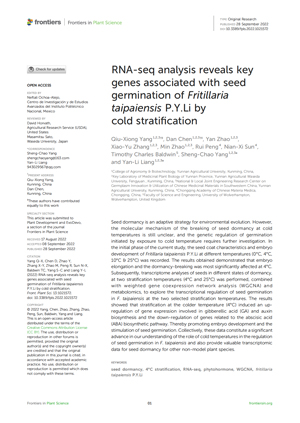NEWS 2022
RNA-seq analysis reveals key genes associated with seed germination of Fritillaria taipaiensis P.Y.Li by cold stratification
Qiu-Xiong YANG1,2,3, Dan CHEN1,2,3, Yan ZHAO1,2,3, Xiao-Yu ZHANG1,2,3, Min ZHAO1,2,3, Rui PENG4, Nian-Xi SUN4, Timothy Charles BALDWIN5, Sheng-Chao YANG1,2,3, Yan-Li LIANG1,2,3
Front. Plant Sci. 13:1021572 (2022)
http://doi.org/10.3389/fpls.2022.1021572
1College of Agronomy & Biotechnology, Yunnan Agricultural University, Kunming, China
2Key Laboratory of Medicinal Plant Biology of Yunnan Province, Yunnan Agricultural Waseda University, Fengyuan , Kunming, China
3National & Local Joint Engineering Research Center on Germplasm Innovation & Utilization of Chinese Medicinal Materials in Southwestern China, Yunnan Agricultural University, Kunming, China
4Chongqing Academy of Chinese Materia Medica, Chongqing, China
5Faculty of Science and Engineering, University of Wolverhampton, Wolverhampton, United Kingdom
Abstract
Seed dormancy is an adaptive strategy for environmental evolution. However, the molecular mechanism of the breaking of seed dormancy at cold temperatures is still unclear, and the genetic regulation of germination initiated by exposure to cold temperature requires further investigation. In the initial phase of the current study, the seed coat characteristics and embryo development of Fritillaria taipaiensis P.Y.Li at different temperatures (0°C, 4°C, 10°C & 25°C) was recorded. The results obtained demonstrated that embryo elongation and the dormancy-breaking was most significantly affected at 4°C. Subsequently, transcriptome analyses of seeds in different states of dormancy, at two stratification temperatures (4°C and 25°C) was performed, combined with weighted gene coexpression network analysis (WGCNA) and metabolomics, to explore the transcriptional regulation of seed germination in F. taipaiensis at the two selected stratification temperatures. The results showed that stratification at the colder temperature (4°C) induced an up-regulation of gene expression involved in gibberellic acid (GA) and auxin biosynthesis and the down-regulation of genes related to the abscisic acid (ABA) biosynthetic pathway. Thereby promoting embryo development and the stimulation of seed germination. Collectively, these data constitute a significant advance in our understanding of the role of cold temperatures in the regulation of seed germination in F. taipaiensis and also provide valuable transcriptomic data for seed dormancy for other non-model plant species.




